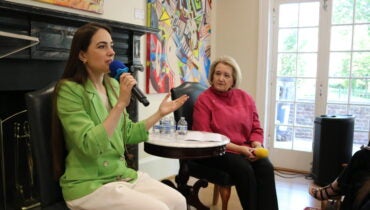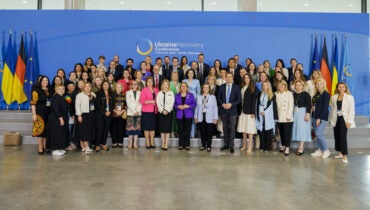This month, we released the first stage of our Women, Peace and Security Conflict Tracker at the Carnegie Corporation of New York headquarters to meet the urgent need for gender-sensitive insight into conflict dynamics.
We interviewed the lead researcher behind the WPS Conflict Tracker, Dr. Jessica Anania, about the goals of the project, which countries it tracks, and what we can expect from the next stages of the initiative.
What is the WPS Conflict Tracker?
The WPS Conflict Tracker brings together real-time data points and original analysis for 25 countries that are at risk of, currently experiencing, or transitioning from armed conflict. The first stage of the initiative is an online dashboard that has information on the risks and opportunities of a particular conflict through a women, peace and security lens. It is focused on women’s status, women’s rights, and women’s protection around the world in conflict. The WPS Conflict Tracker is made possible with support from Carnegie Corporation of New York and The Embassy of Denmark, Washington D.C.
Which countries will you be tracking?
We are tracking 25 countries around the world that are at different stages of the conflict cycle. In the case of transitioning countries, we’re capturing the period after a conflict seemingly ends or a peace process is signed and tracking the status of women in that aftermath as well. Selected countries reflect current events while ensuring geographic coverage and diversity of conflict dynamics. We are currently monitoring: Afghanistan, Central African Republic, Colombia, Democratic Republic of the Congo, Ethiopia, Haiti, Indonesia, Iran, Iraq, Israel and Palestine, Kosovo, Lebanon, Libya, Mali, Mozambique, Myanmar, Niger, Pakistan, Philippines, Somalia, South Sudan, Sudan, Syria, Ukraine, and Yemen.
How do you get your data for the WPS Conflict Tracker?
We got the data for the WPS Conflict Tracker by reviewing 80 different quantitative and qualitative indicators. We collected data on a range of questions, looking at factors from the number of women in a national parliament to observing patterns of conflict-related sexual violence. We did a really in-depth review and then did a holistic assessment drawing from that data, and of course from conversations with our partners and networks on the ground to determine the risks, opportunities and WPS trajectory that we feature on the WPS Conflict Tracker.
What can we expect from the WPS Conflict Tracker in the future?
We are developing detailed pages for the countries that we track. These pages will include in-depth analysis, monitoring, resources, advocacy points—basically everything you need to know about that country and that conflict through a WPS lens.
What inspired this initiative?
This initiative was inspired by the huge need for more gender-sensitive data and analysis on conflict. Too often, women are left out of these conversations and left out of this research. The WPS Conflict Tracker is the first dedicated conflict monitoring tool that is looking specifically through this gender lens and putting women at the fore.
What’s the main goal of the WPS Conflict Tracker?
The main goal of the WPS Conflict Tracker is to be a resource for advocacy and talking points, and to monitor and analyze how conflict dynamics are impacting women’s status and the WPS agenda. For instance, if there’s a new peace process, what does that mean for women? The WPS Conflict Tracker was also created to showcase emerging trends and developments cross-nationally across the 25 countries that we’re monitoring.
What surprised you most when going through the data?
What surprised me most when going through the data was that for every country that we’re monitoring, no matter how difficult the circumstances, we were able to find a WPS opportunity to flag, giving that bit of hope for the conflicts that we’re tracking.
What’s one fact about conflict and women’s security you wish everyone knew?
One fact I wish people knew about women in conflict and security was just how much women bring to these spaces. Women’s issues are not siloed issues when it comes to conflict. Research shows that having women at the table strengthens things like peace agreements and our own work on the WPS Conflict Tracker shows that at the local and national level women are bringing so much to these conversations, to these issues, and just how vital it is that they be included at all levels.


